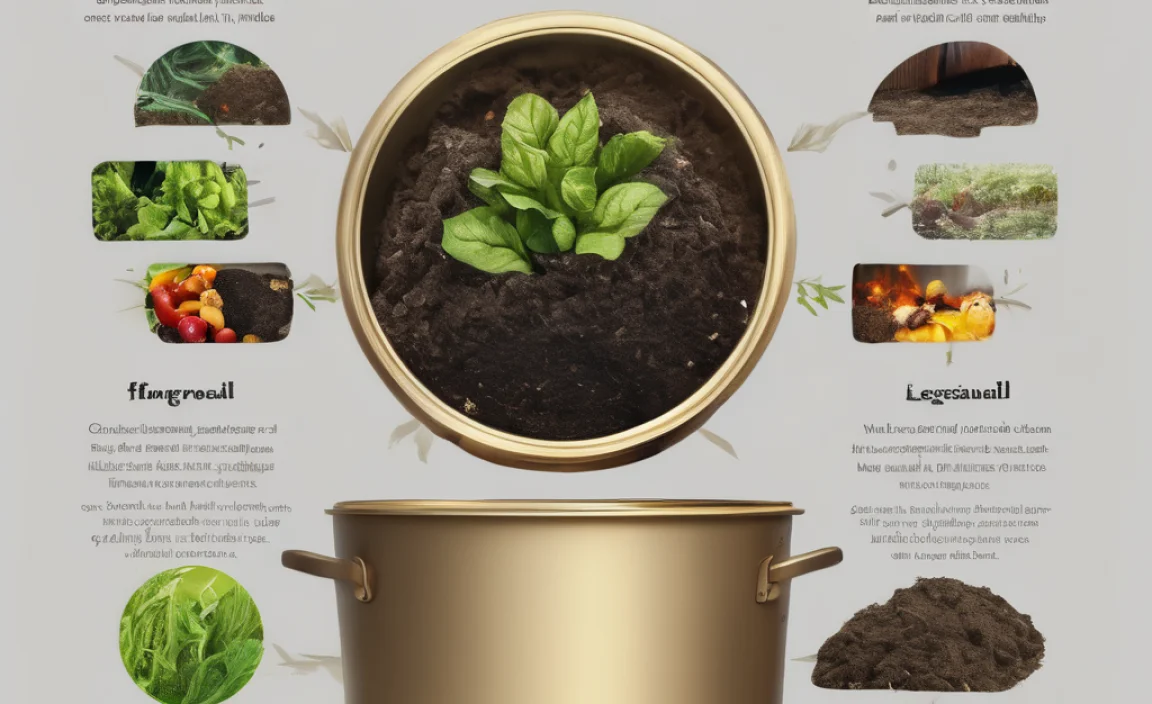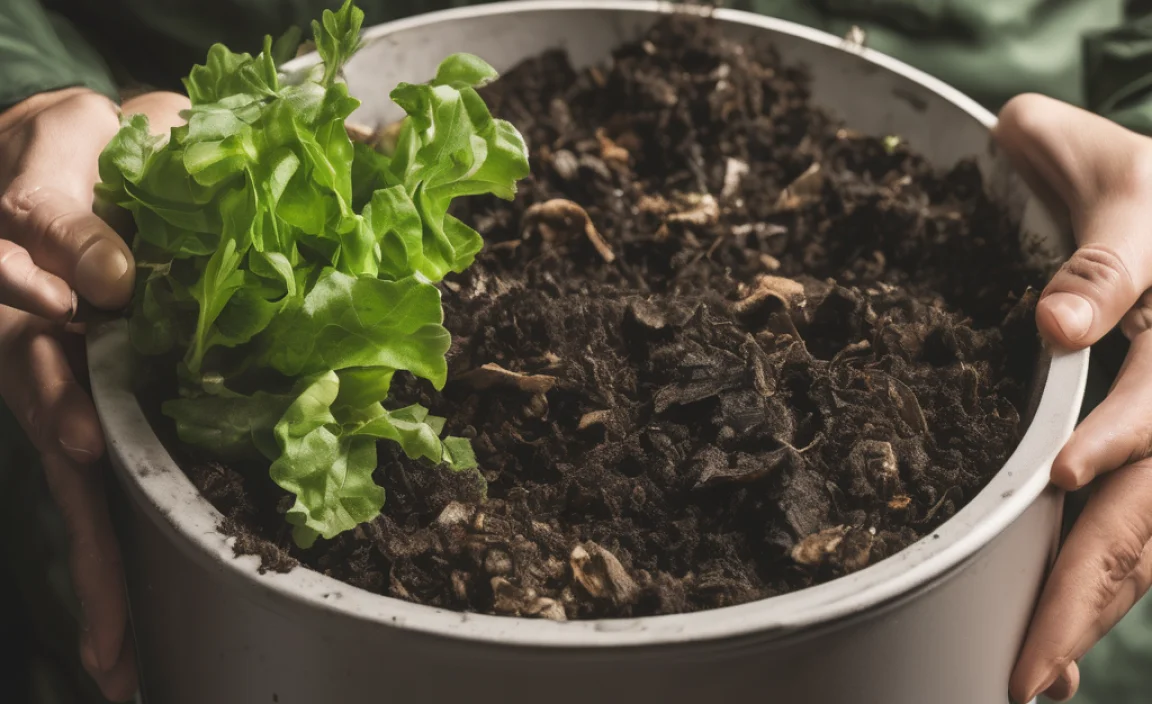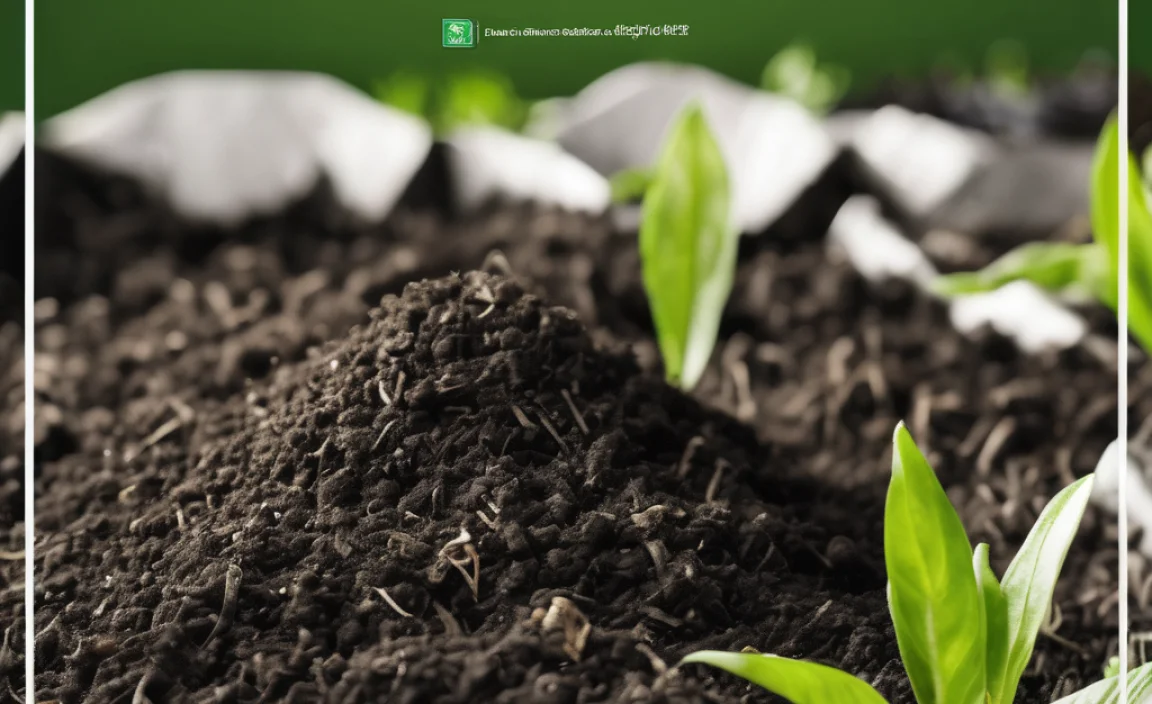Ever wonder what’s really happening inside your compost bin? It’s a bustling city of tiny helpers! These are compost microbes, and understanding them is key to faster, better compost. Thinking about compost microbes and how they work can feel a bit like science class, but it’s totally doable. We’ll break down how these microscopic marvels speed up decomposition, saving you time and giving you nutrient-rich garden gold. Stick around, and we’ll unravel the mystery of compost microbes in no time!
Compost Microbes Time: Unlocking the Secret to Speedy, Super Compost
Hey there, fellow compost enthusiasts! Troy D Harn here, your go-to guy for making home projects, gardening, and yes, even composting, as simple as can be. You’ve probably seen your scraps turn into dark, crumbly goodness, but have you ever stopped to think about who or what is doing all the hard work? It’s a microscopic army known as compost microbes!
These tiny organisms are the real MVPs of your compost pile. Without them, you’d just have a pile of decaying kitchen scraps and yard waste. But with them? You get nutrient-rich soil conditioner that your plants will absolutely love. The “time” part of compost microbes is where things get really interesting. Knowing how to encourage them means you can speed up the whole composting process significantly.
So, what exactly are these microscopic workers, and how do they make compost happen faster? That’s what we’re diving into today. We’ll explore the essential breakthrough in understanding compost microbes and time, turning your compost pile from a slow-burn project into a speedy success. Get ready to become a compost microbe master!
What Are Compost Microbes and Why Should You Care?
Think of a compost pile as a busy restaurant for microorganisms. These microbes are living organisms, mostly bacteria and fungi, but also include protozoa and nematodes. They are naturally present in soil, on plants, and in organic matter. Their job? To break down complex organic materials into simpler substances, eventually transforming your waste into humus – that dark, fertile material known as compost.
Here’s the simple truth: the faster these microbes work, the faster you get compost. And a faster compost turnaround means:
- Less waiting time for that amazing soil amendment.
- More efficient use of your space (smaller pile, less time).
- Quicker replenishment of your garden’s nutrients.
Understanding the conditions these microbes need to thrive is the biggest “breakthrough” for any home composter looking to optimize their efforts. It’s not magic; it’s science, and it’s totally manageable!
The Key Players: A Look at Compost Microbes
While you can’t see them without a microscope, it’s helpful to know who’s in your compost crew. The main characters are:
Bacteria
These are the most abundant microbes in your compost pile. They come in various types, including:
- Mesophilic bacteria: These are the initial decomposers. They work best at moderate temperatures (around 50-105°F or 10-40°C) and start breaking down compounds like sugars and starches.
- Thermophilic bacteria: As the mesophiles work, the pile heats up. This is when thermophilic bacteria (heat-loving) take over. They thrive in temperatures between 105-160°F (40-70°C). This high-heat phase is crucial for killing weed seeds and pathogens.
- Actinobacteria: These are also heat-tolerant and look a bit like fungi. They are excellent at breaking down tougher materials like woody stems and tough plant tissues, giving compost that earthy smell.
Fungi
Fungi, like molds and yeasts, are also vital. They are particularly good at breaking down complex organic compounds that bacteria struggle with, such as lignin (found in wood) and cellulose. They often appear as white, thread-like structures called hyphae.
Other Microscopic Life
While bacteria and fungi do the heavy lifting, other organisms like protozoa, nematodes, and even larger creatures like mites and springtails play roles in the ecosystem by consuming bacteria and fungi, thus helping to further break down material and distribute heat and moisture.
The “Time” Factor: What Accelerates Decomposition?
The speed at which your compost breaks down – the “compost microbes time” – is directly related to how well you manage their environment. These microbes need four key things to be happy and work efficiently:
- Food: A good mix of carbon-rich “browns” and nitrogen-rich “greens.”
- Water: Moisture levels similar to a wrung-out sponge.
- Air: Oxygen is essential for aerobic microbes.
- Temperature: Optimal ranges that encourage different types of microbes to do their jobs.
When these four elements are balanced, your compost pile becomes a vibrant ecosystem where decomposition happens much faster. Think of it as providing the perfect conditions for your microscopic crew to throw the best decomposition party!

The Crucial Ingredients: Balancing Browns and Greens
This is perhaps the most frequently discussed aspect of composting, and for good reason. The ratio of carbon (browns) to nitrogen (greens) dictates the energy source for your microbes. Too much of one can slow things down.
What are Browns? (Carbon-Rich)
Browns provide the energy source for the microbes. They are typically dry and bulky, allowing for good air circulation.
- Dry leaves
- Straw or hay
- Shredded newspaper and cardboard (avoid glossy paper)
- Wood chips or sawdust (use sparingly, as they break down slowly)
- Pine needles
- Eggshells (crushed)
What are Greens? (Nitrogen-Rich)
Greens provide the protein and moisture needed for microbial reproduction and activity. They tend to be wet and can sometimes compact if not balanced.
- Fruit and vegetable scraps
- Coffee grounds and tea bags
- Grass clippings (allow to dry slightly to avoid matting)
- Plant trimmings (non-woody)
- Manure (from herbivores like cows, chickens, rabbits)
- Seaweed
The Ideal Ratio
A common guideline is a ratio of about 25-30 parts carbon to 1 part nitrogen by weight. In terms of volume, this often translates to roughly 2-3 parts browns to 1 part greens. Don’t stress about an exact measurement; it’s more about aiming for a good mix. If your pile smells like ammonia, you probably have too many greens. If it’s not heating up and just sitting there, you likely need more greens.
A great resource for understanding the basic science behind composting and nutrient content of common materials can be found from university extension services. For example, the Oregon State University Extension offers valuable, research-backed information on composting practices.
Moisture: The Unsung Hero of Microbial Activity
Microbes need water to live and to transport nutrients. A compost pile that is too dry will significantly slow down or even halt decomposition. On the other hand, a pile that is too wet will become waterlogged, pushing out oxygen and promoting the growth of anaerobic microbes, which lead to stinky, slow-composting conditions.
The “Wring-Out Sponge Test” is your best friend here. Grab a handful of compost material from the middle of your pile. When you squeeze it, you should only get a few drops of water, if any, and it shouldn’t stream out. If it’s dripping heavily, it’s too wet. If it feels dry and crumbly, it needs more moisture.
Tips for managing moisture:
- Too Dry? Add water. Turn the pile as you water to ensure it soaks in evenly. You can also add wetter green materials.
- Too Wet? Add dry brown materials (like shredded cardboard or dry leaves) and turn the pile to introduce air and absorb excess moisture.
- Rainy Climates? Consider covering your compost bin with a tarp, especially during heavy downpours, ensuring there’s still airflow.
Airflow: Feeding the Aerobic Army
The “hungry” microbes that work fastest and produce the best compost are aerobic, meaning they need oxygen. A compact, soggy pile limits oxygen, stifling these helpful microbes and leading to the dreaded sour smell of anaerobic decomposition.
How to ensure good airflow:
- Turn Your Pile: Regularly turning or “fluffing” your compost pile introduces oxygen throughout. Aim to turn it at least once a week, or once every couple of weeks if you’re in less of a hurry.
- Layering: Alternate layers of bulky browns with finer greens. Browns act like little sponges, creating air pockets as they break down.
- Aeration Tools: Consider using a compost aerator tool. These are long, crank-like devices that you can plunge into the pile and twist to mix and aerate without excessive turning.
- Bin Design: If you have a bin, ensure it has plenty of ventilation holes. Many commercial bins are designed with this in mind. Wire mesh bins also offer excellent airflow.
A simple but effective way to aerate is to use a pitchfork or a shovel to turn the outer layers into the center and vice-versa. This ensures all parts of the pile get exposure to oxygen.
Temperature: The Thermometer of Composting Success
When your compost pile has the right balance of food, water, and air, the microbial activity will generate heat. This heat is a fantastic indicator that things are working well and is crucial for effective composting.
The Temperature Stages:
- Psychrophilic (Cool) Phase: Mesophilic microbes start the process at ambient temperatures.
- Mesophilic (Warm) Phase: As decomposition begins, the temperature rises.
- Thermophilic (Hot) Phase: If the pile is large enough (at least 3x3x3 feet is ideal for heat retention) and balanced, temperatures can soar to 130-165°F (55-74°C). This phase is critical for killing pathogens and weed seeds. A compost thermometer is a handy tool to track this. You can find them at most garden centers or online. For instance, GarrettCompost offers a durable, professional-grade compost thermometer.
- Cooling Down: As the readily available food sources are consumed, the temperature drops back down, and mesophilic microbes begin to reinvade, processing the remaining materials.
What if it doesn’t heat up?
- Too small: The pile needs mass to retain heat.
- Too dry: Add water.
- Not enough nitrogen: Add more green materials.
- Needs turning: Mix materials to aerate and distribute moisture/heat.
The “time” factor here is that a hot compost pile breaks down significantly faster than a cold one. What might take months in a cool pile can be significantly accelerated in a hot pile, sometimes producing finished compost in as little as 4-6 weeks!
The “Breakthrough” Moment: It’s All About Balance
The “essential breakthrough” in compost microbes time isn’t really a single, sudden discovery. Instead, it’s realizing that speeding up composting is less about a secret ingredient and more about mastering the balance of the fundamental elements.
Think of it like this:
| Compost Element | Why It Matters for Microbes | How to Manage for Faster Composting | Signs of Imbalance |
|---|---|---|---|
| Food (Browns/Greens) | Provides energy and building blocks for microbes. | Aim for a 2-3:1 volume ratio of browns to greens. Chop materials smaller to increase surface area. Add diverse materials. | Too many greens: Smells like ammonia. Pile might be too wet. Too many browns: Pile won’t heat up, decomposition is slow. |
| Water | Essential for microbial life and nutrient transport. | Keep moist like a wrung-out sponge. Add water when turning; add browns if too wet. | Too wet: Smells sour or like rotten eggs. Slow decomposition. Too dry: Microbial activity stops. Pile feels dry. |
| Air | Oxygen is vital for aerobic microbes, the fastest decomposers. | Turn the pile regularly. Use a bin with good ventilation. Layer bulky browns for air pockets. | Lack of air (anaerobic): Smells rotten or like sulfur. Slimy texture. |
| Temperature | Indicates microbial activity. High temps kill pathogens and speed breakdown. | Ensure pile is large enough (3x3x3 ft) and balanced for thermophilic stage. Turn to create heat. A compost thermometer helps monitor. | No heat: Pile is too small, too dry, or lacks nitrogen. |
The breakthrough is understanding that you are the conductor of this microbial orchestra. By providing the right conditions – the food, water, air, and temperature – you orchestrate rapid decomposition.
Practical Application: Making Your Compost Work Faster
So how do you apply this knowledge?
- Chop It Up: Smaller pieces have more surface area for microbes to attack. Run over leaves with a mower, chop up tougher kitchen scraps, and shred cardboard.
- Build a Sensible Size Pile: For hot composting, a minimum size of 3 feet cubed (1 cubic yard or about 1 cubic meter) is recommended to generate and retain heat. If your bin is smaller, you’ll still get compost, but it will be a slower, “cold” compost process.
- Layering Strategy: Start with a layer of coarse browns (twigs) for drainage and airflow at the bottom. Then alternate layers of greens and browns, aiming for that 2-3:1 brown-to-green volume ratio. Finish with a layer of browns on top to minimize odors and flies.
- Active Turning: If you want compost fast, turn your pile every 5-7 days and add water as needed. This keeps the microbes happy and working.
- Monitor and Adjust: Keep an eye (and a nose!) on your pile. Does it smell? Is it too wet or too dry? Adjust your brown/green ratio, moisture, or turning schedule accordingly.
You don’t need fancy equipment. A pitchfork, a shovel, a water hose, and a willingness to get your hands a little dirty are all you truly need. For those interested in the science of decomposition and microbial ecology, resources like EPA’s composting guide offer further reading.
Troubleshooting Common Composting “Issues”
Even with the best intentions, things can sometimes go awry. Here are common signs of imbalance and how to fix them:
- Smelly Pile (Ammonia/Rotten Egg Smell): Usually means too much nitrogen (greens) or it’s too wet, leading to anaerobic conditions.
Fix: Add a generous amount of brown materials and turn the pile thoroughly to introduce air. - Pile Not Heating Up: Could be too dry, too small, or lacking nitrogen.
Fix: Check moisture and add water if needed. Add more green materials. If the pile is too small, try to add more organic matter over time to increase its mass. - Slow Decomposition: Often due to one or more of the four key elements being out of balance, or materials are too large.
Fix: Ensure proper brown-to-green ratio, adequate moisture, and good airflow. Chop materials into smaller pieces. - Attracting Pests (Flies, Rodents): Usually caused by exposed food scraps or an imbalance.
Fix: Ensure food scraps are buried in the center of the pile and always covered with a layer of brown material. Avoid adding meat scraps, dairy, or oily foods, as these attract pests and can go putrid.
How Long Does it Really Take?
This is where “compost microbes time” becomes very practical. The timeline for finished compost

I am passionate about home engineering. I specialize in designing, installing, and maintaining heating, ventilation, and air conditioning systems. My goal is to help people stay comfortable in their homes all year long.



